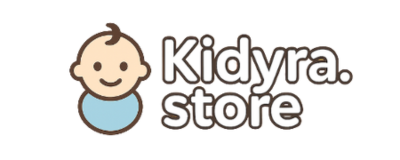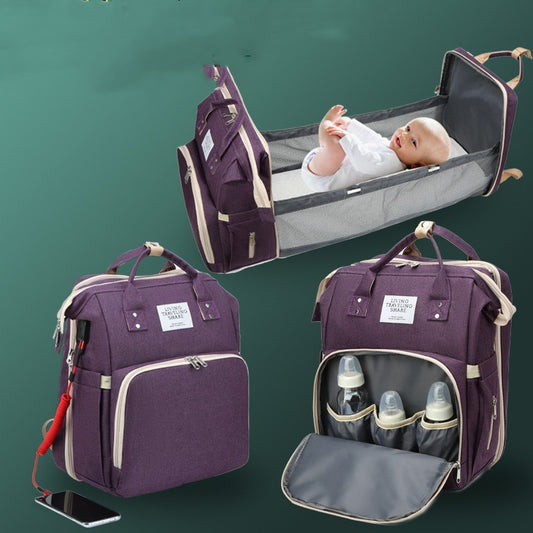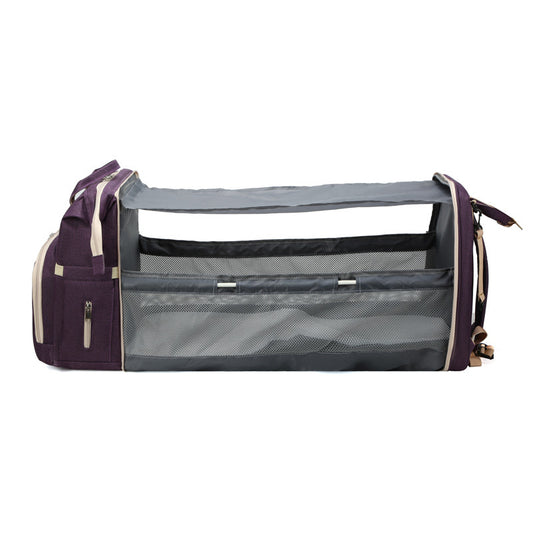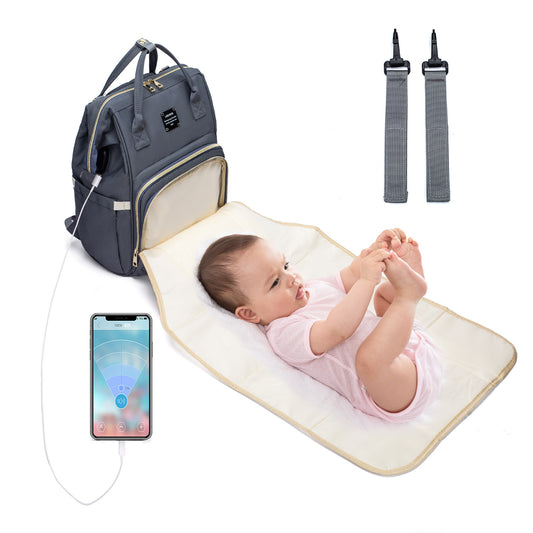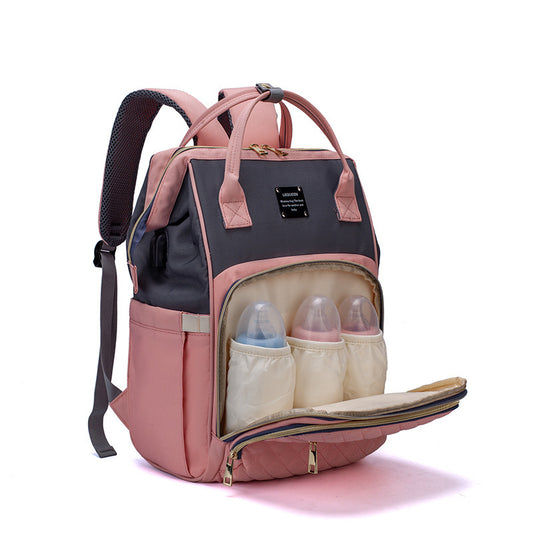As a new parent, every purchase matters — especially when it involves items used daily and on-the-go. One of the most important things you’ll invest in early is a baby changing bag. But many parents ask a crucial question:
Are baby changing bags safe for storing newborn essentials?
In short — yes, but only if you're using a well-designed bag and packing it strategically.
This guide explores:
-
The safety of using baby changing bags for newborns
-
How to properly store nappies, milk, creams, and clothes in your bag
-
Materials to look for (and avoid)
-
Daily-use safety mistakes to avoid
-
Tips to keep your baby bag hygienic, functional, and safe
What Essentials Go into a Baby Changing Bag for Newborns?
When you're caring for a newborn, your changing bag should carry the following:
-
Nappies (3 to 5)
-
Packs of sensitive baby wipes
-
Barrier cream or nappy rash ointment
-
Sterilised milk bottles or breast milk containers
-
A clean outfit (vest, sleepsuit, socks)
-
Foldable changing mat
-
Dummy and/or soft comfort toy
-
Hand sanitiser
-
Muslin cloth or bib
The question of safety comes down to how these items are stored. Keeping feeding items and personal care products safe from cross-contamination is key.
Are Modern Baby Changing Bags Designed for Safety?
Yes. The majority of contemporary baby changing bags are designed specifically around real-world use, ensuring everyday safety and hygiene.
Here are the core features that contribute to safety:
Waterproof or Wipeable Linings
Prevents mould or bacteria by making cleanup easy after milk, cream, or food spills.
Separate Compartments
Allows feeding supplies, used clothes, and personal items to be stored separately, limiting chances of contamination.
Thermal Bottle Holders
Regulates milk temperature and protects other contents from spillage or condensation.
External Wipe Pockets
Makes nappy changes faster and cleaner. Limits contact with bacteria-prone public changing areas.
Tear-Resistant Stitching and Reinforced Fabric
Helps the bag withstand daily use without sharp threads, loose fabric, or broken seals that could pose a risk.
Common Mistakes That Can Lead to Unsafe Conditions
Even with a high-quality bag, how it's used can introduce sanitation or safety concerns.
Here are some habits to avoid:
Packing Wet or Used Items With Clean Ones
Mixing used clothes or wipes with fresh baby gear inside the same space can spread bacteria. Always use a waterproof wet pouch or designated section.
No Bottle Insulation
Uninsulated or incorrectly stored bottles can spoil faster, especially in warmer weather or long days out.
Overpacking
An overloaded bag compresses delicate items like bottles or creams, increasing the chance of leakage or breakage that may not be noticed right away.
Mixing Parent Items With Baby Essentials
Coins, pens, phones, and cosmetics can carry germs. They should be stored in fully separate compartments.
How to Choose a Safe Baby Changing Bag: Features and Materials
When buying a bag for newborns, prioritise the following:
Wipeable Interior Fabric
Clean-up should be fast and effective. Choose bags with waterproof, soft linings that don’t absorb moisture.
Structured Compartments
Look for designs that include distinct zones for feeding, nappy changing, and clothing.
Leak-Proof Bottle Sections
Insulated bottle holders are essential for storing formula or breast milk. They minimise the risk of spoilage or methane gas buildup in closed milk bottles.
Vegan Leather or Waterproof Oxford Fabric
Avoid uncoated cotton or fabrics that retain moisture. Oxford fabric is durable, light, and naturally water-resistant.
Reinforced Zip Closures and Base Panels
Helps keep the interior sealed properly and allows the bag to stand upright, minimising spills and damage when placed on the ground.
Safe Packing Strategy for Newborns (Step-by-Step)
Stacking everything in one main compartment makes it harder and less sanitary to fetch what you need. Instead, use the following method:
Quick-Access Front Pockets
-
Dummy in a clean case
-
Muslin or burp cloth
-
Hand sanitiser
-
Tissues or baby wipes
Internal Organiser Pouch or Wet Bag
-
Clean clothes
-
Nappies
-
Barrier cream or ointment
Use zip-lock style pouches or dedicated fabric organisers to keep dry items together.
Insulated Bottle Holders
-
Ensure bottles are fully sealed
-
Clip milk bottle cases in upright position
-
Place away from wipe packets or cloth items
Parent’s Section (Exterior Back or Side Panel)
-
Wallet
-
House keys
-
Medical ID or health card
-
Phone or tech accessories
This area should never touch the interior where clean baby essentials are stored.
Are All Baby Bags Equally Safe?
No, definitely not. Budget or fashion-first changing bags often lack interior divisions, lining material, or insulation. Here’s what to avoid:
-
Single-compartment bags with no bottle or wipe holder
-
Cotton interiors without water resistance
-
Outer materials that stain easily or retain odours
-
Sharp or exposed zipper teeth near quick-access zones
-
Overly soft designs with no internal support (risks crush and spill)
Always read product material specifications and confirmed use cases on reputable websites before you buy.
How Safe Are the Changing Mats Inside Baby Bags?
Removable changing mats are useful for changing nappies outside the home, but the mat should:
-
Be foldable
-
Wipe clean with antibacterial wipes
-
Have no loose stuffing or seams
-
Avoid scented or textured inner layers that could irritate newborn skin
Clean the mat after each use and store separately from feeding supplies or clothes.
Child-Safe Bags from Kidyra.Store: Product Highlights
From the available product data, both of the following bags meet safety standards for storing newborn essentials:
Large Diaper Bag Backpack with Insulated Pockets & Changing Mat
-
Oxford waterproof outer fabric
-
Two insulated bottle zones
-
Rear access pocket
-
Wipe-clean and antibacterial zip lining
-
Foldable cot-style changing mat for naps
-
Tear-resistant construction
Large Nappy Backpack with Insulated Pockets & USB Port
-
USB port for travel charging (keep wires away from baby’s section)
-
Separate bottle storage
-
Durable waterproof material
-
Cushioned straps for better balance when walking with baby
-
Slim, modern format for easy public use
Each provides specific areas for feeding, clothes, nappy changes, and parent items — allowing you to pack for baby without compromise.
Conclusion
A well-structured and high-quality baby changing bag is absolutely safe for storing even the most sensitive newborn essentials — especially when used properly.
Choose a modern, compartmentalised design with waterproof linings, separate insulated sections, cleanable changing mats, and defined spaces for parent and baby gear.
The safest option? Combine a secure bag with thoughtful packing routines and regular cleaning. Doing so ensures your newborn’s needs are always met — safely, hygienically, and comfortably.
Looking for a newborn-safe baby changing bag with built-in organisation and hygiene-focused design?
Browse our collection of safe, spacious, parent-approved changing bags built for everyday life and long-term use.
FAQs
Q1. Is it safe to store baby formula in a changing bag?
Yes, if placed in a secure, insulated compartment and used within the advised time frame. Always keep it upright and tightly sealed.
Q2. Can a baby changing bag cause health risks?
Only if used improperly. Store clean and soiled items separately, sanitise regularly, and always inspect bottle zones for leaks.
Q3. How do I keep the inside of a baby bag germ-free?
Wipe the lining weekly with warm water and baby-safe sanitizer. Keep soiled items in zip pouches or removable wet bags.
Q4. Are insulated pockets essential for safety?
Insulated bottle holders improve temperature consistency and reduce spoilage risk. For formula-fed or expressed milk, they’re highly recommended.
Q5. Should tech items be stored beside baby gear?
No. Use a separate side or back pocket for phones, cables, or laptops to prevent bacterial transfer or accidental spills.
